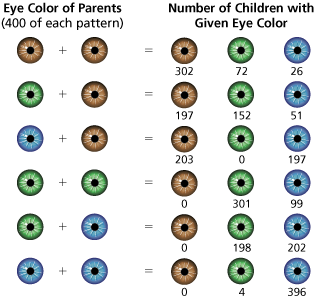-
Here are some observations about the sample shown in Example 3.
- If neither of the parents has brown eyes, then there is no chance of the children having brown eyes. (Hint: Look at the last three rows of the table.)
- If both parents have blue eyes, there is an extremely high probability (99%) that their children will have blue eyes.
- If one parent has blue eyes and the other has brown eyes, then there is no chance of their children having green eyes.

-
Macular degeneration and cataracts are two diseases that can affect your eyes as you age. By following healthy lifestyle habits, you can decrease your risk of getting these diseases. Want to learn more? Watch this video from The Today Show.
-
Of the 400 children with two brown-eyed parents, 302 have brown eyes, 72 have green eyes, and 26 have blue eyes. So the probability is

-
Comments (0)
These comments are not screened before publication. Constructive debate about the information on this page is welcome, but personal attacks are not. Please do not post comments that are commercial in nature or that violate copyright. Comments that we regard as obscene, defamatory, or intended to incite violence will be removed. If you find a comment offensive, you may flag it.
When posting a comment, you agree to our Terms of Use.Showing 0 commentsSubscribe by email Subscribe by RSSThere are no comments.





